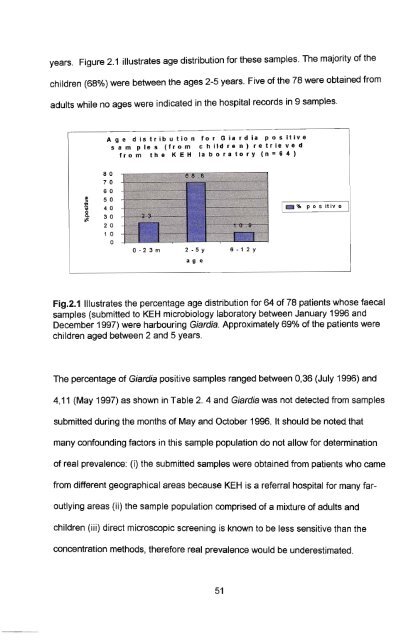in vitro culture and isoenzyme analysis of giardia lamblia
in vitro culture and isoenzyme analysis of giardia lamblia
in vitro culture and isoenzyme analysis of giardia lamblia
Create successful ePaper yourself
Turn your PDF publications into a flip-book with our unique Google optimized e-Paper software.
years. Figure 2.1 illustrates age distribution for these samples. The majority <strong>of</strong> the<br />
children (68%) were between the ages 2-5 years. Five <strong>of</strong> the 78 were obta<strong>in</strong>ed from<br />
adults while no ages were <strong>in</strong>dicated <strong>in</strong> the hospital records <strong>in</strong> 9 samples.<br />
Age distribution for Giardia positive<br />
sam pies (from children) retrieved<br />
from the KEH laboratory (n=64)<br />
..<br />
8 0<br />
7 0<br />
60<br />
~ 5 0<br />
.;;; 40<br />
o<br />
~ 30<br />
2 0<br />
1 0<br />
o<br />
0-2 3 m 2 - 5 Y 6 - 1 2 Y<br />
age<br />
1_ % po s itiv e 1<br />
Fig.2.1 Illustrates the percentage age distribution for 64 <strong>of</strong> 78 patients whose faecal<br />
samples (submitted to KEH microbiology laboratory between January 1996 <strong>and</strong><br />
December 1997) were harbour<strong>in</strong>g Giardia. Approximately 69% <strong>of</strong> the patients were<br />
children aged between 2 <strong>and</strong> 5 years.<br />
The percentage <strong>of</strong> Giardia positive samples ranged between 0,36 (July 1996) <strong>and</strong><br />
4,11 (May 1997) as shown <strong>in</strong> Table 2. 4 <strong>and</strong> Giardia was not detected from samples<br />
submitted dur<strong>in</strong>g the months <strong>of</strong> May <strong>and</strong> October 1996. It should be noted, that<br />
many confound<strong>in</strong>g factors <strong>in</strong> this sample population do not allow for determ<strong>in</strong>ation<br />
<strong>of</strong> real prevalence: (i) the submitted samples were obta<strong>in</strong>ed from patients who came<br />
from different geographical areas because KEH is a referral hospital for many faroutly<strong>in</strong>g<br />
areas (ii) the sample population comprised <strong>of</strong> a mixture <strong>of</strong> adults <strong>and</strong><br />
children (iii) direct microscopic screen<strong>in</strong>g is known to be less sensitive than the<br />
concentration methods, therefore real prevalence would be underestimated.<br />
51
















